service CHEVROLET EXPRESS CARGO VAN 2016 1.G CNG Manual
[x] Cancel search | Manufacturer: CHEVROLET, Model Year: 2016, Model line: EXPRESS CARGO VAN, Model: CHEVROLET EXPRESS CARGO VAN 2016 1.GPages: 30, PDF Size: 0.63 MB
Page 2 of 30
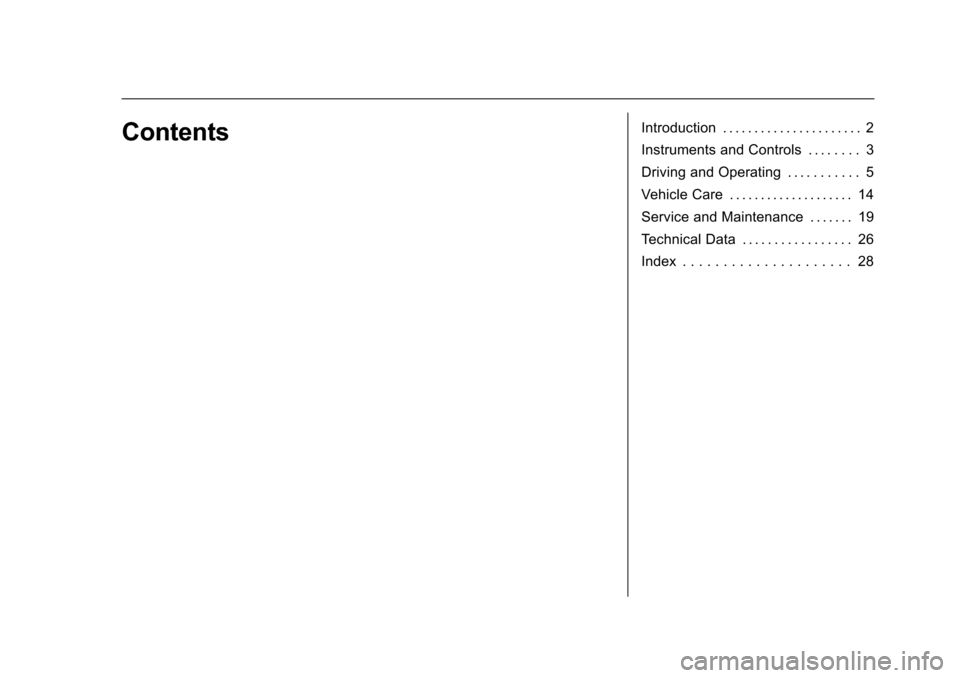
Chevrolet/GMC Express/Savana CNG Compressed Natural Gas Supplement
(GMNA-Localizing-U.S/Canada-9159237) - 2016 - crc - 6/18/15
ContentsIntroduction . . . . . . . . . . . . . . . . . . . . . . 2
Instruments and Controls . . . . . . . . 3
Driving and Operating . . . . . . . . . . . 5
Vehicle Care . . . . . . . . . . . . . . . . . . . . 14
Service and Maintenance . . . . . . . 19
Technical Data . . . . . . . . . . . . . . . . . 26
Index . . . . . . . . . . . . . . . . . . . . . 28
Page 3 of 30
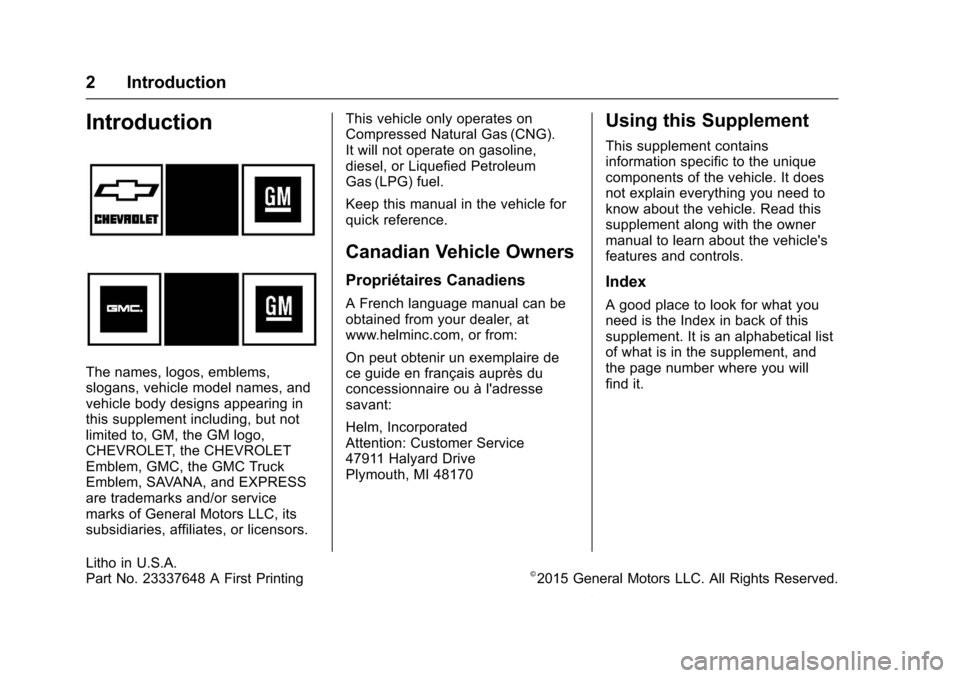
Chevrolet/GMC Express/Savana CNG Compressed Natural Gas Supplement
(GMNA-Localizing-U.S/Canada-9159237) - 2016 - crc - 6/18/15
2 Introduction
Introduction
The names, logos, emblems,
slogans, vehicle model names, and
vehicle body designs appearing in
this supplement including, but not
limited to, GM, the GM logo,
CHEVROLET, the CHEVROLET
Emblem, GMC, the GMC Truck
Emblem, SAVANA, and EXPRESS
are trademarks and/or service
marks of General Motors LLC, its
subsidiaries, affiliates, or licensors.This vehicle only operates on
Compressed Natural Gas (CNG).
It will not operate on gasoline,
diesel, or Liquefied Petroleum
Gas (LPG) fuel.
Keep this manual in the vehicle for
quick reference.
Canadian Vehicle Owners
Propriétaires Canadiens
A French language manual can be
obtained from your dealer, at
www.helminc.com, or from:
On peut obtenir un exemplaire de
ce guide en français auprès du
concessionnaire ou à l'adresse
savant:
Helm, Incorporated
Attention: Customer Service
47911 Halyard Drive
Plymouth, MI 48170
Using this Supplement
This supplement contains
information specific to the unique
components of the vehicle. It does
not explain everything you need to
know about the vehicle. Read this
supplement along with the owner
manual to learn about the vehicle's
features and controls.
Index
A good place to look for what you
need is the Index in back of this
supplement. It is an alphabetical list
of what is in the supplement, and
the page number where you will
find it.
Litho in U.S.A.
Part No. 23337648 A First Printing©2015 General Motors LLC. All Rights Reserved.
Page 5 of 30
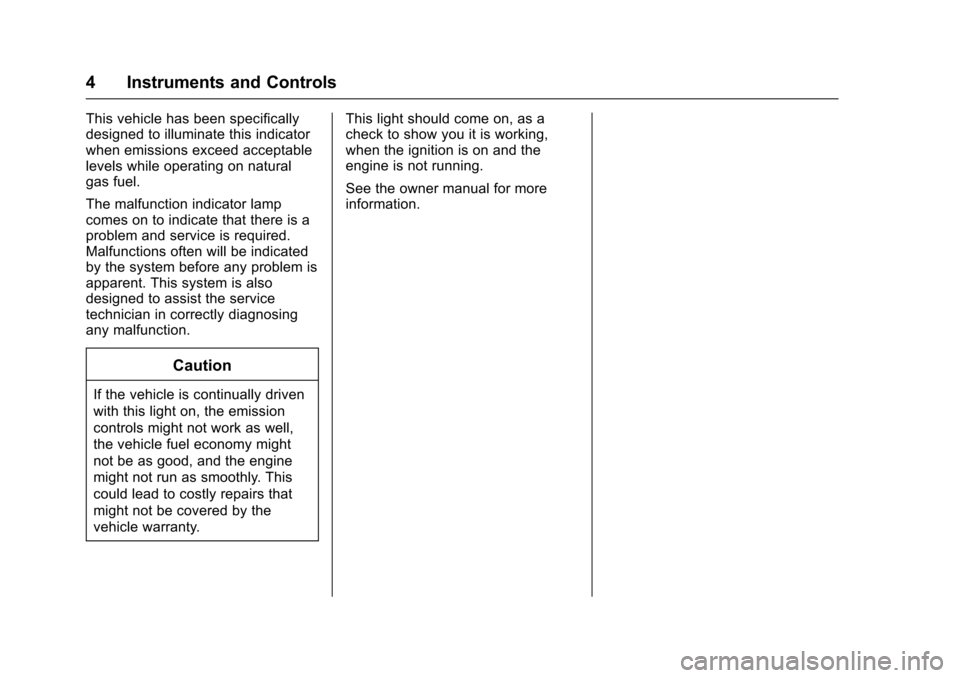
Chevrolet/GMC Express/Savana CNG Compressed Natural Gas Supplement
(GMNA-Localizing-U.S/Canada-9159237) - 2016 - crc - 6/18/15
4 Instruments and Controls
This vehicle has been specifically
designed to illuminate this indicator
when emissions exceed acceptable
levels while operating on natural
gas fuel.
The malfunction indicator lamp
comes on to indicate that there is a
problem and service is required.
Malfunctions often will be indicated
by the system before any problem is
apparent. This system is also
designed to assist the service
technician in correctly diagnosing
any malfunction.
Caution
If the vehicle is continually driven
with this light on, the emission
controls might not work as well,
the vehicle fuel economy might
not be as good, and the engine
might not run as smoothly. This
could lead to costly repairs that
might not be covered by the
vehicle warranty.This light should come on, as a
check to show you it is working,
when the ignition is on and the
engine is not running.
See the owner manual for more
information.
Page 7 of 30
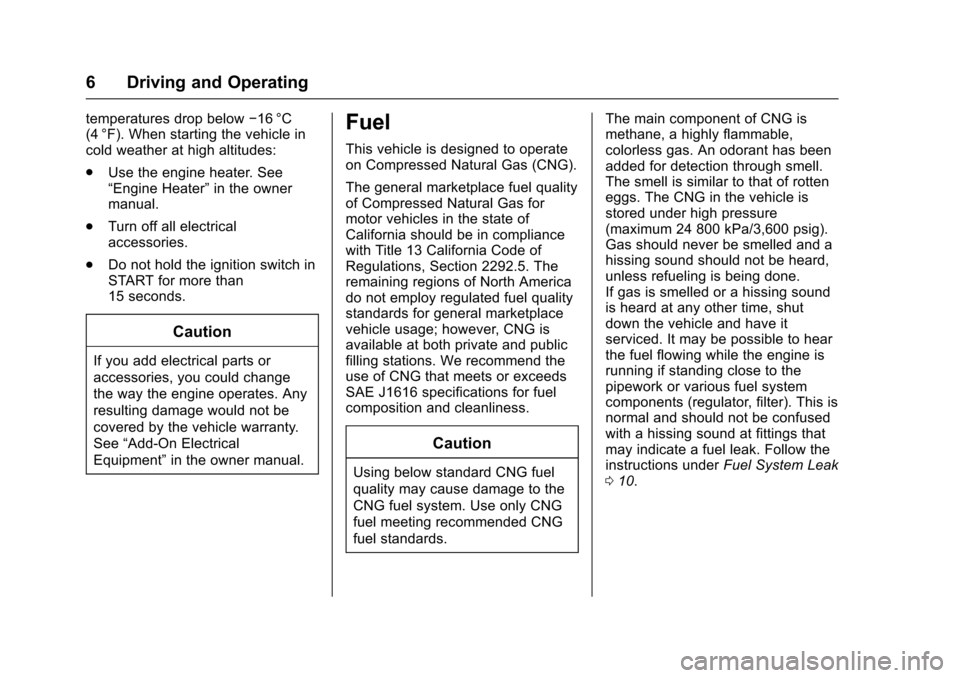
Chevrolet/GMC Express/Savana CNG Compressed Natural Gas Supplement
(GMNA-Localizing-U.S/Canada-9159237) - 2016 - crc - 6/18/15
6 Driving and Operating
temperatures drop below−16 °C
(4 °F). When starting the vehicle in
cold weather at high altitudes:
. Use the engine heater. See
“Engine Heater” in the owner
manual.
. Turn off all electrical
accessories.
. Do not hold the ignition switch in
START for more than
15 seconds.
Caution
If you add electrical parts or
accessories, you could change
the way the engine operates. Any
resulting damage would not be
covered by the vehicle warranty.
See “Add-On Electrical
Equipment” in the owner manual.
Fuel
This vehicle is designed to operate
on Compressed Natural Gas (CNG).
The general marketplace fuel quality
of Compressed Natural Gas for
motor vehicles in the state of
California should be in compliance
with Title 13 California Code of
Regulations, Section 2292.5. The
remaining regions of North America
do not employ regulated fuel quality
standards for general marketplace
vehicle usage; however, CNG is
available at both private and public
filling stations. We recommend the
use of CNG that meets or exceeds
SAE J1616 specifications for fuel
composition and cleanliness.
Caution
Using below standard CNG fuel
quality may cause damage to the
CNG fuel system. Use only CNG
fuel meeting recommended CNG
fuel standards. The main component of CNG is
methane, a highly flammable,
colorless gas. An odorant has been
added for detection through smell.
The smell is similar to that of rotten
eggs. The CNG in the vehicle is
stored under high pressure
(maximum 24 800 kPa/3,600 psig).
Gas should never be smelled and a
hissing sound should not be heard,
unless refueling is being done.
If gas is smelled or a hissing sound
is heard at any other time, shut
down the vehicle and have it
serviced. It may be possible to hear
the fuel flowing while the engine is
running if standing close to the
pipework or various fuel system
components (regulator, filter). This is
normal and should not be confused
with a hissing sound at fittings that
may indicate a fuel leak. Follow the
instructions under
Fuel System Leak
0 10.
Page 9 of 30
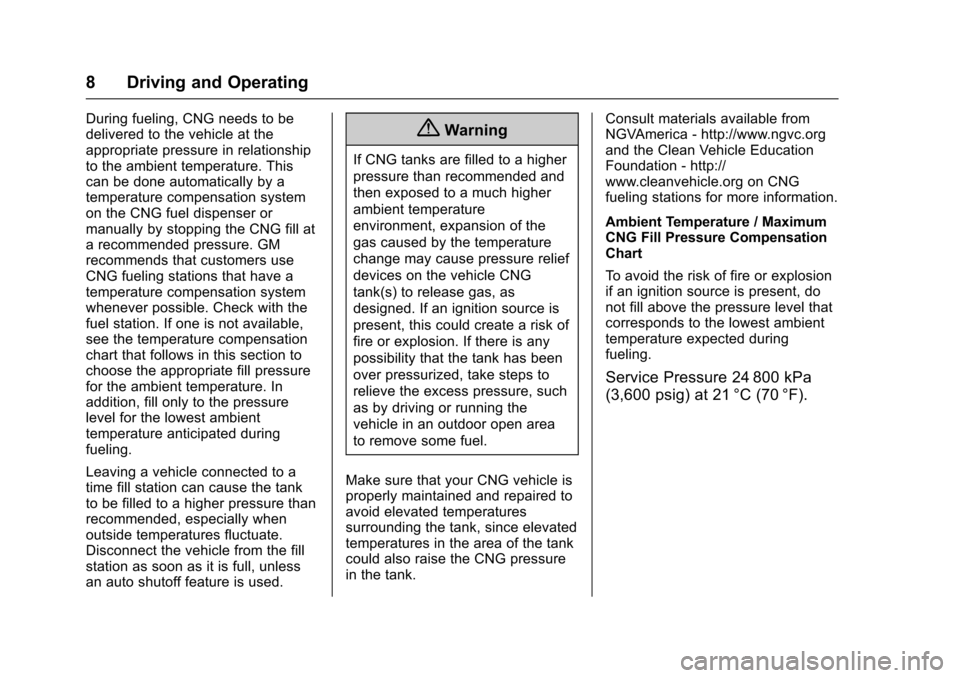
Chevrolet/GMC Express/Savana CNG Compressed Natural Gas Supplement
(GMNA-Localizing-U.S/Canada-9159237) - 2016 - crc - 6/18/15
8 Driving and Operating
During fueling, CNG needs to be
delivered to the vehicle at the
appropriate pressure in relationship
to the ambient temperature. This
can be done automatically by a
temperature compensation system
on the CNG fuel dispenser or
manually by stopping the CNG fill at
a recommended pressure. GM
recommends that customers use
CNG fueling stations that have a
temperature compensation system
whenever possible. Check with the
fuel station. If one is not available,
see the temperature compensation
chart that follows in this section to
choose the appropriate fill pressure
for the ambient temperature. In
addition, fill only to the pressure
level for the lowest ambient
temperature anticipated during
fueling.
Leaving a vehicle connected to a
time fill station can cause the tank
to be filled to a higher pressure than
recommended, especially when
outside temperatures fluctuate.
Disconnect the vehicle from the fill
station as soon as it is full, unless
an auto shutoff feature is used.{Warning
If CNG tanks are filled to a higher
pressure than recommended and
then exposed to a much higher
ambient temperature
environment, expansion of the
gas caused by the temperature
change may cause pressure relief
devices on the vehicle CNG
tank(s) to release gas, as
designed. If an ignition source is
present, this could create a risk of
fire or explosion. If there is any
possibility that the tank has been
over pressurized, take steps to
relieve the excess pressure, such
as by driving or running the
vehicle in an outdoor open area
to remove some fuel.
Make sure that your CNG vehicle is
properly maintained and repaired to
avoid elevated temperatures
surrounding the tank, since elevated
temperatures in the area of the tank
could also raise the CNG pressure
in the tank. Consult materials available from
NGVAmerica - http://www.ngvc.org
and the Clean Vehicle Education
Foundation - http://
www.cleanvehicle.org on CNG
fueling stations for more information.
Ambient Temperature / Maximum
CNG Fill Pressure Compensation
Chart
To avoid the risk of fire or explosion
if an ignition source is present, do
not fill above the pressure level that
corresponds to the lowest ambient
temperature expected during
fueling.
Service Pressure 24 800 kPa
(3,600 psig) at 21 °C (70 °F).
Page 11 of 30
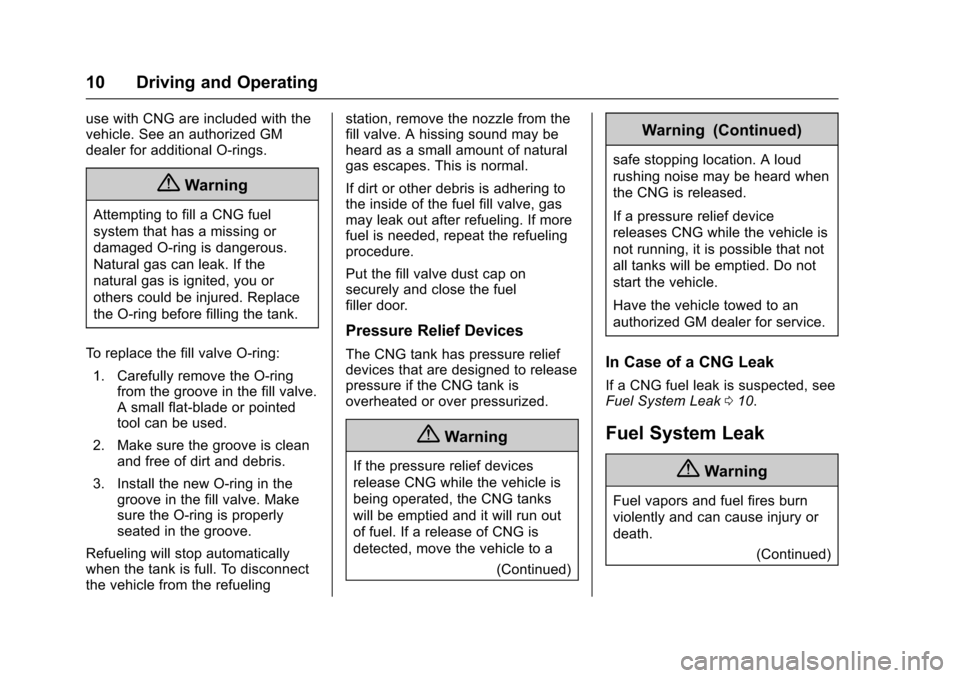
Chevrolet/GMC Express/Savana CNG Compressed Natural Gas Supplement
(GMNA-Localizing-U.S/Canada-9159237) - 2016 - crc - 6/18/15
10 Driving and Operating
use with CNG are included with the
vehicle. See an authorized GM
dealer for additional O-rings.
{Warning
Attempting to fill a CNG fuel
system that has a missing or
damaged O‐ring is dangerous.
Natural gas can leak. If the
natural gas is ignited, you or
others could be injured. Replace
the O‐ring before filling the tank.
To replace the fill valve O-ring: 1. Carefully remove the O-ring from the groove in the fill valve.
A small flat-blade or pointed
tool can be used.
2. Make sure the groove is clean and free of dirt and debris.
3. Install the new O-ring in the groove in the fill valve. Make
sure the O-ring is properly
seated in the groove.
Refueling will stop automatically
when the tank is full. To disconnect
the vehicle from the refueling station, remove the nozzle from the
fill valve. A hissing sound may be
heard as a small amount of natural
gas escapes. This is normal.
If dirt or other debris is adhering to
the inside of the fuel fill valve, gas
may leak out after refueling. If more
fuel is needed, repeat the refueling
procedure.
Put the fill valve dust cap on
securely and close the fuel
filler door.
Pressure Relief Devices
The CNG tank has pressure relief
devices that are designed to release
pressure if the CNG tank is
overheated or over pressurized.
{Warning
If the pressure relief devices
release CNG while the vehicle is
being operated, the CNG tanks
will be emptied and it will run out
of fuel. If a release of CNG is
detected, move the vehicle to a
(Continued)
Warning (Continued)
safe stopping location. A loud
rushing noise may be heard when
the CNG is released.
If a pressure relief device
releases CNG while the vehicle is
not running, it is possible that not
all tanks will be emptied. Do not
start the vehicle.
Have the vehicle towed to an
authorized GM dealer for service.
In Case of a CNG Leak
If a CNG fuel leak is suspected, see
Fuel System Leak010.
Fuel System Leak
{Warning
Fuel vapors and fuel fires burn
violently and can cause injury or
death.
(Continued)
Page 12 of 30
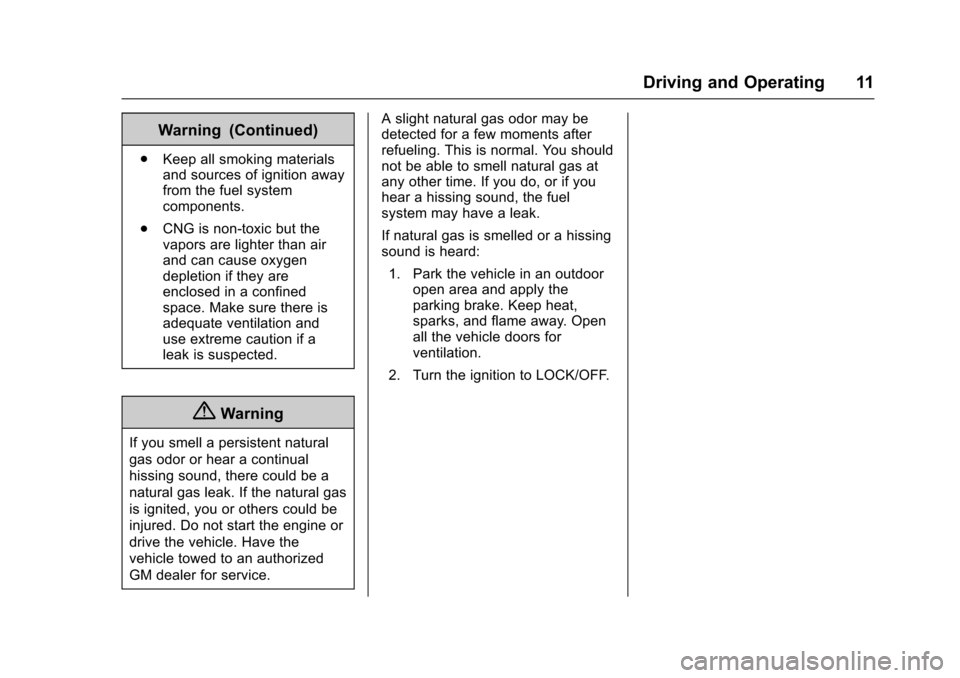
Chevrolet/GMC Express/Savana CNG Compressed Natural Gas Supplement
(GMNA-Localizing-U.S/Canada-9159237) - 2016 - crc - 6/18/15
Driving and Operating 11
Warning (Continued)
.Keep all smoking materials
and sources of ignition away
from the fuel system
components.
. CNG is non-toxic but the
vapors are lighter than air
and can cause oxygen
depletion if they are
enclosed in a confined
space. Make sure there is
adequate ventilation and
use extreme caution if a
leak is suspected.
{Warning
If you smell a persistent natural
gas odor or hear a continual
hissing sound, there could be a
natural gas leak. If the natural gas
is ignited, you or others could be
injured. Do not start the engine or
drive the vehicle. Have the
vehicle towed to an authorized
GM dealer for service. A slight natural gas odor may be
detected for a few moments after
refueling. This is normal. You should
not be able to smell natural gas at
any other time. If you do, or if you
hear a hissing sound, the fuel
system may have a leak.
If natural gas is smelled or a hissing
sound is heard:
1. Park the vehicle in an outdoor open area and apply the
parking brake. Keep heat,
sparks, and flame away. Open
all the vehicle doors for
ventilation.
2. Turn the ignition to LOCK/OFF.
Page 15 of 30
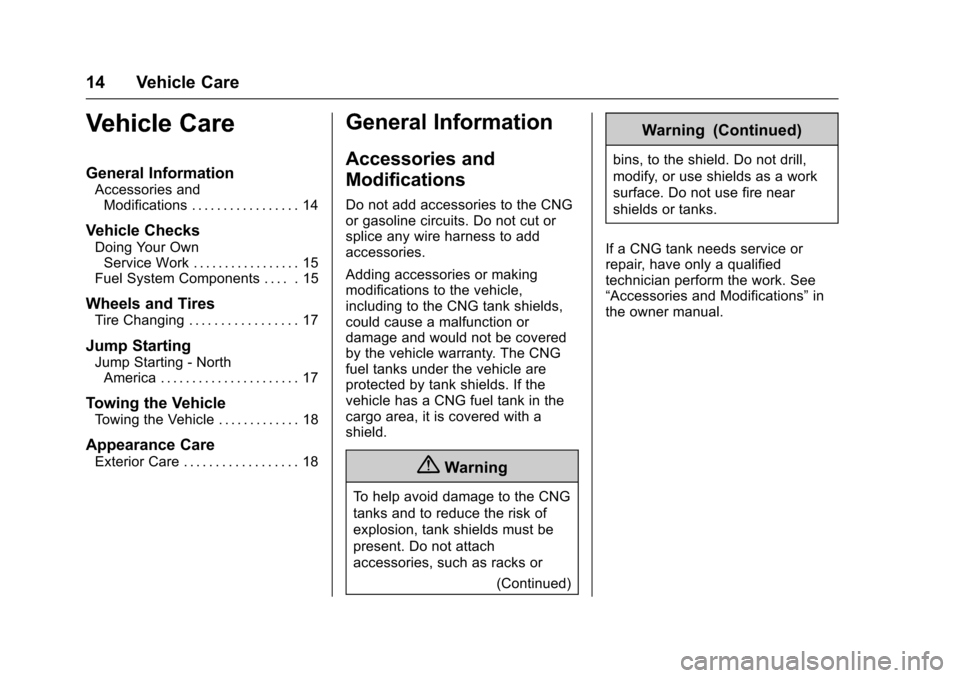
Chevrolet/GMC Express/Savana CNG Compressed Natural Gas Supplement
(GMNA-Localizing-U.S/Canada-9159237) - 2016 - crc - 6/18/15
14 Vehicle Care
Vehicle Care
General Information
Accessories andModifications . . . . . . . . . . . . . . . . . 14
Vehicle Checks
Doing Your OwnService Work . . . . . . . . . . . . . . . . . 15
Fuel System Components . . . . . 15
Wheels and Tires
Tire Changing . . . . . . . . . . . . . . . . . 17
Jump Starting
Jump Starting - North America . . . . . . . . . . . . . . . . . . . . . . 17
Towing the Vehicle
Towing the Vehicle . . . . . . . . . . . . . 18
Appearance Care
Exterior Care . . . . . . . . . . . . . . . . . . 18
General Information
Accessories and
Modifications
Do not add accessories to the CNG
or gasoline circuits. Do not cut or
splice any wire harness to add
accessories.
Adding accessories or making
modifications to the vehicle,
including to the CNG tank shields,
could cause a malfunction or
damage and would not be covered
by the vehicle warranty. The CNG
fuel tanks under the vehicle are
protected by tank shields. If the
vehicle has a CNG fuel tank in the
cargo area, it is covered with a
shield.
{Warning
To help avoid damage to the CNG
tanks and to reduce the risk of
explosion, tank shields must be
present. Do not attach
accessories, such as racks or
(Continued)
Warning (Continued)
bins, to the shield. Do not drill,
modify, or use shields as a work
surface. Do not use fire near
shields or tanks.
If a CNG tank needs service or
repair, have only a qualified
technician perform the work. See
“Accessories and Modifications” in
the owner manual.
Page 16 of 30
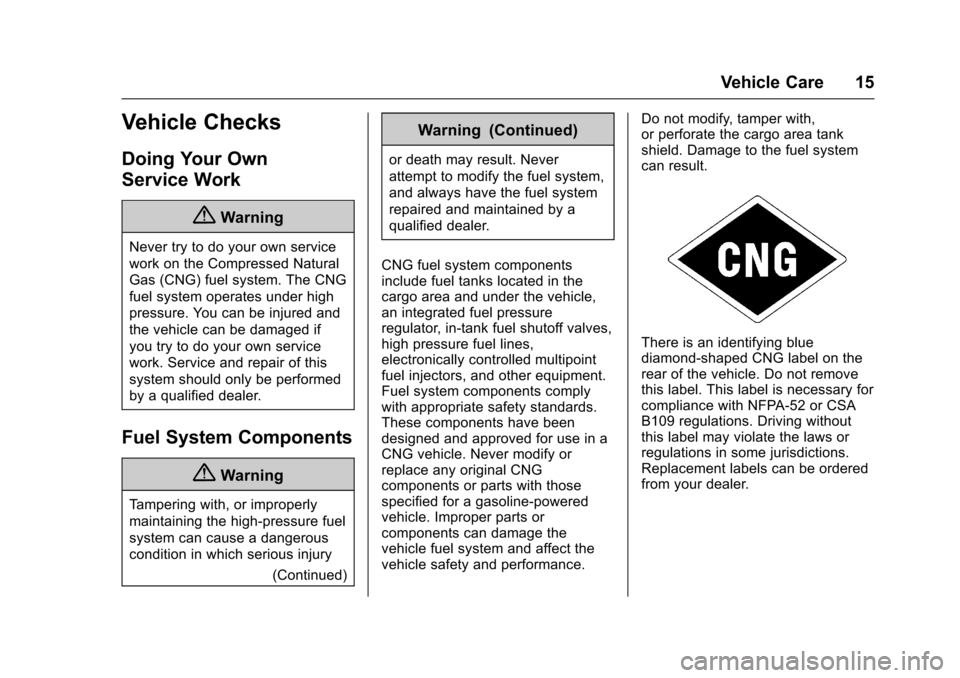
Chevrolet/GMC Express/Savana CNG Compressed Natural Gas Supplement
(GMNA-Localizing-U.S/Canada-9159237) - 2016 - crc - 6/18/15
Vehicle Care 15
Vehicle Checks
Doing Your Own
Service Work
{Warning
Never try to do your own service
work on the Compressed Natural
Gas (CNG) fuel system. The CNG
fuel system operates under high
pressure. You can be injured and
the vehicle can be damaged if
you try to do your own service
work. Service and repair of this
system should only be performed
by a qualified dealer.
Fuel System Components
{Warning
Tampering with, or improperly
maintaining the high-pressure fuel
system can cause a dangerous
condition in which serious injury(Continued)
Warning (Continued)
or death may result. Never
attempt to modify the fuel system,
and always have the fuel system
repaired and maintained by a
qualified dealer.
CNG fuel system components
include fuel tanks located in the
cargo area and under the vehicle,
an integrated fuel pressure
regulator, in-tank fuel shutoff valves,
high pressure fuel lines,
electronically controlled multipoint
fuel injectors, and other equipment.
Fuel system components comply
with appropriate safety standards.
These components have been
designed and approved for use in a
CNG vehicle. Never modify or
replace any original CNG
components or parts with those
specified for a gasoline-powered
vehicle. Improper parts or
components can damage the
vehicle fuel system and affect the
vehicle safety and performance. Do not modify, tamper with,
or perforate the cargo area tank
shield. Damage to the fuel system
can result.
There is an identifying blue
diamond-shaped CNG label on the
rear of the vehicle. Do not remove
this label. This label is necessary for
compliance with NFPA-52 or CSA
B109 regulations. Driving without
this label may violate the laws or
regulations in some jurisdictions.
Replacement labels can be ordered
from your dealer.
Page 18 of 30
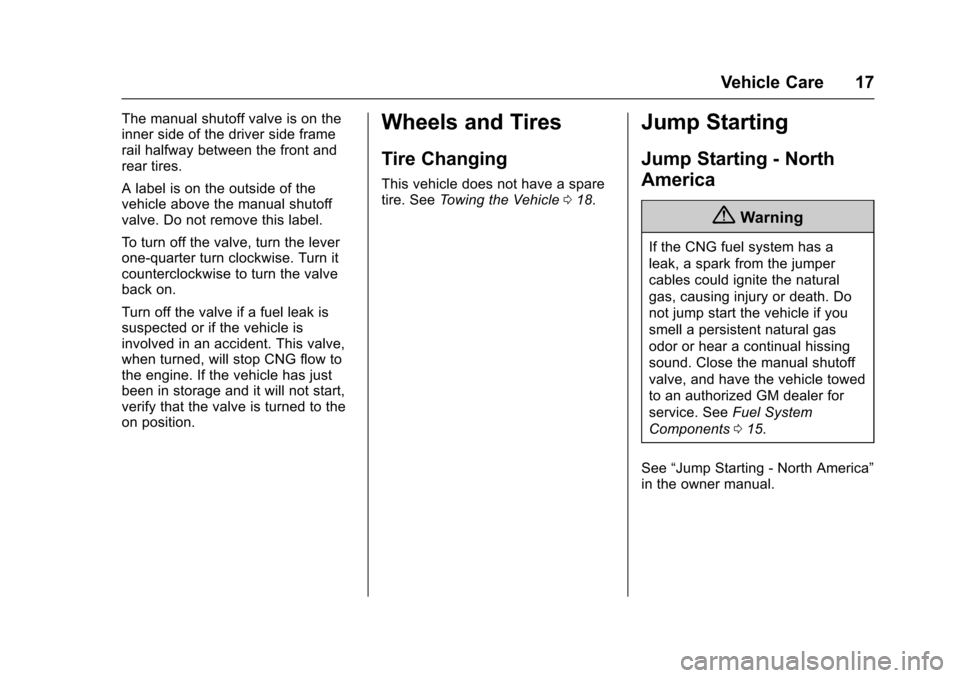
Chevrolet/GMC Express/Savana CNG Compressed Natural Gas Supplement
(GMNA-Localizing-U.S/Canada-9159237) - 2016 - crc - 6/18/15
Vehicle Care 17
The manual shutoff valve is on the
inner side of the driver side frame
rail halfway between the front and
rear tires.
A label is on the outside of the
vehicle above the manual shutoff
valve. Do not remove this label.
To turn off the valve, turn the lever
one-quarter turn clockwise. Turn it
counterclockwise to turn the valve
back on.
Turn off the valve if a fuel leak is
suspected or if the vehicle is
involved in an accident. This valve,
when turned, will stop CNG flow to
the engine. If the vehicle has just
been in storage and it will not start,
verify that the valve is turned to the
on position.Wheels and Tires
Tire Changing
This vehicle does not have a spare
tire. SeeTowing the Vehicle 018.
Jump Starting
Jump Starting - North
America
{Warning
If the CNG fuel system has a
leak, a spark from the jumper
cables could ignite the natural
gas, causing injury or death. Do
not jump start the vehicle if you
smell a persistent natural gas
odor or hear a continual hissing
sound. Close the manual shutoff
valve, and have the vehicle towed
to an authorized GM dealer for
service. See Fuel System
Components 015.
See “Jump Starting - North America”
in the owner manual.